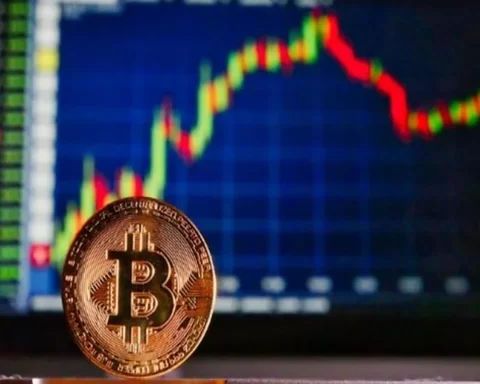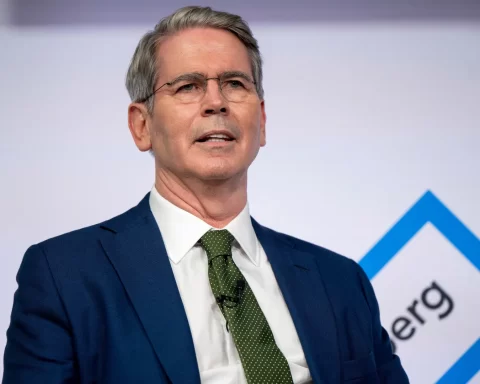Serhii Tron, founder of White Rock Management, one of the largest mining companies in the world, spoke on the current state of the crypto market, and shared his vision of what comes next this year
What are the most valuable lessons we can learn from 2023?
What’s most important – and quite obvious for everybody – is that the crypto winter, the topic that so many people fueled their devastating forecasts with in 2022, is over and done with. A stone-cold fact, which I am not sure why anybody has any reason to question. The market did have to plough through a lot, but last year, the price of bitcoin leapt by 150%, and hit a $44 thousand mark. There were, of course, some corrections and fallbacks, however, the outcome is still very much on the bright side, so there are few people bringing up the $17 thousand indicator from November 2022.
BTC capitalization once again exceeded $816 billion. If you look at the entire market, you can see the capitalization growth of 2023 was a solid 108.1% – from $829 billion to $1.72 trillion, with the annual trade volumes reaching $36 trillion. Doesn’t feel like winter to me.
Were the external factors involved?
Naturally, there were many things at play, for the crypto market does not exist by itself. Back in 2022, world regulators had to handle the aftermath of the COVID-19 pandemic and forced monetary emission (to help businesses stay afloat and keep the wolf of the global crisis at the door) – monetary policies had to tighten in order to keep the global inflation at bay. Very active in this endeavor was the U.S. Federal Reserve, which raised their basic rates. But, by the end of 2023, the Feds softened a bit, with the consumer prices gradually going down.

Two major events took place in the United States: at the year’s start, the state regulator had to interfere and save the banks in distress (Silicon Valley Bank, Signature Bank) by means of its own Bank Term Funding Program (BTFP), which basically means a lot of money (around $400 billion) had to be pumped into the failing institutions; as the monetary policies eased up a little, the said money incrementally spread across the markets. For the loan and stock markets, and crypto market to boot, the money influx worked like a charm. Dollar instruments’ profitability decreased, but it went up in our segment, hence it feels like a natural order of things, all things considered.
Declining unemployment rates across the world and GDP growth were some other positive factors. Geopolitical tensions are still on the rise, though. I’m speaking about not only military actions in Ukraine and Israel, but the attacks on ships in the Red Sea, and bad blood between North/South Korea, and China/Taiwan.
On the bright side, people happened to notice the financial regulators are pretty interested in crypto. I am, of course, talking about the scandals and law suits against several crypto-dealing enterprises after FTX closure, which made a lot of market players really worried. Some even said it was about to bring the eternal winter upon our market. Which did not happen, by the way, as we soldiered on. I believe that, at least in part, it was possible thanks to the settlement that one of the world’s largest platforms Binance agreed to. Even though the company was fined, this solution is widely considered the optimal choice under the very tricky circumstances. The court hearings on another stock market (Coinbase) are still afoot, but we stay hopeful that both sides can also come to an agreement.
Do you think the state authorities will keep on pushing?
Most certainly, yes. Not in a bad way only, though, by imposing even more pressure and limitations. We can see that many regulators remain unmoved, and are dead-set to not accept crypto for what it is. However, it is pretty much common understanding that digital assets are the future. It doesn’t need to be fought; it needs to be reasonably regulated instead.

Yes, the regulations must be reasonable: measures of control need to be in place so that bitcoin and other coins are not used in arms deals and drug trade; the investors need to be protected from scoundrels and thieves. That being said, excessive regulations need to perish, for they only hold back development of the market and some necessary instruments.
Are you now speaking of the 10-year war with the U.S. regulator for BTC ETFs?
I’m now speaking in general. Surely, BTC ETFs implementation in the United States took way longer than it should have, and it definitely should have happened much sooner. However, hats off to the U.S. Securities and Exchange Commission (SEC) for what they did in January 2024. The entire market has been anticipating this move since the summer of 2023, when BlackRock applied for this instrument after the watershed court ruling in the Grayscale Investments case: this one company was the sole most persistent proponent of this instrument, and basically served as a trailblazer for the market as a whole.
I would like to point out, though, that many political figures warmed up to the crypto market last year. Robert Francis Kennedy Jr. (nephew of the legendary 35th U.S. President JFK), Democratic Party member and U.S. presidential candidate, openly supported crypto, and was the one to admit that bitcoin can back up the dollar exchange rate; he also compared BTC to gold. A lot was done in terms of lobbying and legislation by the U.S. Senator (Rep) Cynthia Lummis. Another vocal supporter of crypto is Javier Milei, the new President of Argentina, who’s put his team on a mission of crypto popularization in his home country. There are more politicians in favor of cryptocurrency: Lichtenstein’s Prime Minister, Minister of Finance Daniel Risch, leader of the Polish party “Porozumienie” (previously “Polska Razem”) Jarosław Govin, and many more political figures, who from their high chairs and offices substantiate the importance of digital assets. More importantly, they take real measures for coins integration.
In my home country of Ukraine, the work on legislative regulations has intensified. Before the full-scale invasion, one specialized law was adopted and signed (“The Law on Virtual Assets”), with one more piece of legislation in the works, which touches upon taxation, regulations, and other minor details. Several drafts have been introduced so far, with ongoing debates in full swing – which is always helpful; I expect the authorities to pay attention to the field experts and find common ground. Despite the sad reality of a fully-fledged atrocious war, popularity of BTC and other coins is only rising: Ukraine is No. 5 (preceded by the United States) on the Chainanalysis list of countries embracing crypto assets. According to this list, we beat Brazil, China, and Turkiye. Once we win this war, and once the legislation is sorted out, BTC in Ukraine will skyrocket.
Even under such conditions, Ukrainian crypto business keeps moving forward, including foreign countries. What are the objectives of your company?
My personal goals at the moment are to make White Rock Management one of the world’s top-3 miners, and make our company public. We are prepared to enter new markets and attract capitals. From day one, we designed our business in a way to be very clear and understandable to our investors. We imposed our principle from the very start (Environmental, Social, and Corporate), and we never messed with loans, which many of our colleagues do; thus, they’re up to the neck in debts.
We might fall short in terms of mining volumes, however, we’re not reliant on massive loans. We have zero debts and optimal EBITDA, which can be proven by three consecutive years of successful audits by international experts. I am certain that we’ll attract a lot of interest.
We are actively developing several projects in Canada and South America. Investment-wise, we’re talking about $100+ million. Also, alternative energy sources, green energy in particular, are one of our top priorities, and we have no intention of pulling back on this path.
This is, by the way, one of the reasons why miners face heavy criticism – excessive energy consumption (competing for it with other industries), especially in the middle of winter in regions burdened with all sorts of troubles…
State authorities of many countries have previously attacked the mining community as our industry was maturing, with some even launching full-scale propaganda campaigns against crypto: they claimed we’re parasites that stand in the way of developing economies. However, it was the miners who turned out to be the most prolific investors in alternative energy sources. Therefore, this angle of critique is no longer valid. There still might be some local complaints in specific regions, yet they are few and far in between.
No other field but crypto does as much to keep the green energy sector in motion. When I meet my colleagues, I find out about new projects on alternative energy sources that are being developed non-stop: for example, Bitfarms representatives spoke very engagingly on the use of hydro power in Norway, Finland, and Sweden, while Bit Digital is powered by the Niagara River in the USA (electric power generated by the currents of the Niagara River); some of our colleagues put to use geothermal power in Iceland. Our own White Rock Management is an avid proponent of hydro energy, but we are also very interested in American projects (Texas) in gas flaring, which help reduce CO2 emissions at the same time. We joined another 250 companies in signing the Crypto Climate Accord agreement that stipulates environmentally friendly and safe mining of crypto.
Do you think this subject will remain in demand in 2024? What is your general forecast for this year?
Yes, I am confident that environmentally friendly projects will remain popular among the miners – I know we’ll keep working on them for sure. This is right, and this is profitable, too, if you make your business work correctly.
Speaking of the crypto market as a whole, a lot will revolve around those new instruments and opportunities for the investors. I am, of course, talking about BTC ETFs that had a pretty solid start in the United States despite the Grayscale sale-off (Grayscale Bitcoin Trust), which people saw coming to begin with. The major share of stock exchange spots ended up in the liquidator’s pocket, FTX, which never denied it was after maximizing profits to pay off the creditors. Sooner or later, these sale-offs will come to an end, with more money gradually flowing into other funds.
I am sure the investments will grow, including the numbers from the retail market. Back in late-January, Google posted first ads of BTC ETFs, a move that will most certainly attract attention of general public across the board. New funds will emerge, not in the U.S. alone: not so long ago, a spot application was filed in Hong Kong, and I’ve faith it will come through. Let’s wait and see when Europe kicks this door flying open, for the big party is yet to start around here. Capitalization and trading volumes will grow, make no mistake about that.
Surely, other products will pass various stages of development too. 2023 saw significant interest in AI-generated tokens (AI segment of the crypto market exceeded 11%), GameFi and even meme-coins – something a lot of us managed to forget about entirely. But, speaking of the mass market, I am sure the lion share of attention will be dedicated to BTC ETFs.
Readers are always curious about expected rates of the main cryptocurrency of all…
I’m not keen on putting exact numbers on things, however, I am confident the price of bitcoin will keep on rising. With some fallbacks and profit locking, perhaps, but still on the rise overall. There are objective reasons for the upward dynamics.
I have mentioned the further expansion of BTC ETFs, which will perpetuate the increasing value of the coin. Let us not forget about another major event, the halving, which will most definitely affect the exchange rate fluctuations. Also, willingly or otherwise, the stimulation of the interest in BTC will depend on the world’s financial regulators that are on the path of easing their monetary policies. U.S. Federal Reserve in particular: American regulator kept the basic rates as they were (5.25-5.5% per annum), but might lower them in this coming March, as inflation retreats and employment rates improve. The next thing to happen will be a natural reaction: a decrease in the profitability of dollar instruments, and an easy flow of capital from the credit and stock markets to the cryptocurrency market, which promises more interesting earnings. This wheel will spin itself, and we will see the price of crypto rise.
Many analysts insist that by the end of the year’s first quarter or beginning of the second, bitcoin will comfortably sit around $50-60 thousand apiece. Who knows, though: should the stars align perfectly, this price tag might be even better.




